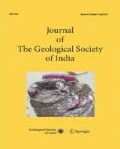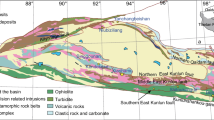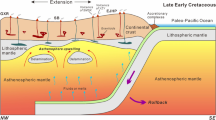Abstract
The Dargawan gabbros intrusive into the Moli Subgroup of Bijawar Group, yielded Rb-Sr whole rock isochron age of 1967 ± 140 Ma. Based on the oldest age from overlying Lower Vindhyan (1.6Ga) and the underlying youngest basement ages (2.2 Ga), the time range of Bijawar sedimentation may be assigned as 2.1–1.6 Ga (Paleoproterozoic). Sm-Nd Model ages (TDM), obtained, for Dargawan gabbros, is c. 2876–3145 Ma. High initial 87Sr/ 86Sr ratio of 0.70451 (higher than the contemporary mantle) and negative ɛNdi (at 1.9 Ga) value of −1.5 to − 4.5, indicate assimilation of Archaean lower crustal component by the enriched mantle source magma at the time of gabbroic intrusion. The dolerite, from Damdama area, which is intrusive into the basement and overlying sediments of Chandrapur Group in the central Indian craton, yielded Rb-Sr internal isochron age of 1641 ± 120 Ma. The high initial 87Sr/86Sr ratio of 0.7098 and ɛNdi value of −3.5 to −3.7 (at 1.6 Ga) is due to contamination of the mantle source magma with the overlying sediments. These dolerites have younger Sm-Nd Model ages (TDM) than Dargawan gabbros as c. 2462–2675 Ma, which is similar to the age of the Sambalpur granite, from which probably sediments to this part of Chattisgarh basin are derived. Hence mixing of sediments with the Damdama dyke during its emplacement, gives rise to high initial 87Sr/86Sr and low initial 143Nd/144 ratios for these dykes. The c. 1600 Ma age indicates minimum age of onset of the sedimentation in the Chandrapur Group of Chattisgarh basin. Both the above mafic intrusions might have taken place in an intracratonic rift related (anorogenic) tectonic setting. This study is the first reliable age report on the onset of sedimentation in the Chandrapur Group. The total minimum time span of Chandrapur and Raipur Group may be 1.6 Ga to 1.0 Ga (Mesoproterozoic). The unconformably underlying Shingora Group of rocks of Chhattisgarh Supergroup thus indicates Paleoproterozoic age (older than 1.6 Ga). Most part of the recently classified Chattisgarh Supergroup and Bijawar-Vindhyan sequence are of Mesoproterozoic-Paleoproterozoic age and not of Neoproterozoic-Mesoproterozoic age as considered earlier. Petrographic study of basic dykes from Damdama area (eastern margin of Chattisgarh Supergroup) indicated presence of primary uranium mineral brannerite associated with goethite. This is the evidence of mafic intrusive providing geotherm and helping in scavenging the uranium from the surrounding and later alterations causing remobilisation and reconcentration of pre-existing uranium in host rocks as well as in mafic dyke itself otherwise mafic rocks are poor source of uranium and can not have primary uranium minerals initially. It can be concluded that mafic dykes have role in uranium mineralisation although indirectly.
Similar content being viewed by others
References
Basu, A., Patranabis-Deb, S., Schieber, J. and Dhang, P. C. (2009) Stratigraphic position of the 1000 Ma Sukhda Tuff (Chhattisgarh Supergroup, India) and the 500 Ma question. Precambrian Res., v.167, pp.383–388.
Bhaskar Rao, Y.J., Pantulu, G.V.C., Reddy, V.D. and Gopalan, K. (1995) Time of early sedimentation and volcanism in the Proterozoic Cuddapah basin, South India: evidence from Rb-Sr age of Pulivendla mafic sill. Mem. Geol. Soc. India, no.33, pp. 329–338.
Chalapathi Rao, N.V., Lehmann, B., Burgess, R., Pande, S.K. and Hari, K.R.M. (2010) Mafic dykes of Deccan age in the Chhattisgarh (Mesoproterozoic) Basin, Central India: implications for the origin and original spatial extent of the Deccan. www.largeigneousprovinces.org
Choudhury, A. K., Naik, A., Mukhopadhyay, D. and Gopalan, K.(1996) Rb-Sr dating of Sambalpur granodiorite, western Orissa. Jour. Geol. Soc. India, v.47(4), pp.503–506.
Crawford, A.R. (1970) The Precambrian geochemistry of Rajasthan and Bundelkhand, Northern India. Can. Jour. Earth Sci., v.125, pp.91–110.
Das, D.P., Kundu, A., Das, N., Dutta, D.R., Kumaran, K., Ramamurthy, S., Thanavelu, C. and Rajaiya, V. (1992) Lithostratigraphy and Sedimentation of Chhattisgarh basin. Indian Minerals, v.46, no.3&4, pp.271–288.
DePaolo, (1981) Trace element and isotopic effects of combined wallrock assimilation and fractional crystallization. Earth Planet. Sci. Lett., v.53, pp.189–202.
Dobmeier, C.J. and Raith, M. M. (2003).Crustal architecture and evolution of the eastern Ghats Belts and adjacent regions of India. In: M. Yoshida, B.F. Windley, and S. Dasgupta (Eds.), Proterozoic East Gondwana: supercontinent assembly and breakup. Geol. Soc. London, Spec. Pub., v.206, pp.145–168.
Fachmann, S. (2001) Geologische Entnicklung im Umfeld des Mahanadi Riftes (Indien). Ph.D. theses, Technische Universitat Bergakademie Freiberg, Germany.
Fogwill, W.D. (1981) Canadian and Saskatchewan uranium deposits: compilation, metallogeny, models, exploration. In: T.I.I. Sibbald and W. Petruk (Eds.), Geology of Uranium deposits, C.I.M. Special volume, v.32, pp.3–19.
French, J.E., Heaman, L.M., Chacko, T., Srivastava, R.K. and Singh, R.K. (2004) U-Pb dating of mafic dyke swarms of the Bastar craton, India. Geochim Cosmochim Acta, v.68(11, Suppl.) A586.
French, J.E., Heaman, L.M., Chacko, T. and Srivastava, R.K. (2008) 1891–1883 Ma Southern Bastar-Cuddapah mafic igneous events, India: a newly recognized large igneous province. Precambrian Res. v., 160, pp.308–322
Gupta, P.K., Rajeeva Ranjan, Mukundan, A.R., Deshpande, M.S.M., Srivastava, V.K. and Yadav, R.S. (2008) Uranium mineralisation along the northeastern margin of Proterozoic Chhattisgarh basin around Chitakhol, Central India: A petromineralogical study. Explo. Res. Atom. Min., v.18, pp.33–53.
Kumar, B., Srivastava, R.K., Jha, D.K., Pant, N.C. and Bhandaru, B.K. (1990) A revised stratigraphy of the rocks of type area of the Bijawar Group in Central India. Indian Minerals, v.44, no.4, pp.303–314.
Ludwig, K.R. (1993) ISOPLOT-A plotting and regression program for radiogenic-isotope data version 2.70. USGS open file report 91-445, 42p.
Milos Rene (2008) Anomalous rare earth element, yttrium and zirconium mobility associated with uranium mineralisation. Terra Nova, v.20(1), pp.52–58.
Mondal, M.E.A., Sharma, K.K., Rahman, A. and Goswami, J.N. (1998) Ion microprobe 207Pb/206Pb zircon ages for gneissgranitoid rocks from Bundelkhand massif: Evidence for Archaean component. Curr. Sci., v.74, no.1, pp.70–75.
Mondal, M.E.A., Goswamy, J.N., Deomurari, M.P. and Sharma, K.K. (2002) Ion microprobe 207Pb/206Pb ages of zircons from the Bundelkhand massif, northern India: implications for crustal evolution of the Bundelkhand-Aravalli protocontinent. Precambrian Res., v.117, pp.413–419.
Murti, K.S. (1987). Sedimentation in Chhattisgarh basin. In Purana Basins of Peninsular India. Mem. Geol. Soc. India, no.6, pp.239–260.
Pandey, B.K., Chabria, T. and Gupta, J.N. (1995) Geochronological characterisation of the Proterozoic terrains of Peninsular India: relevance to the first order target selection for uranium exploration. Explo. Res. Atom. Min., v.8, pp.187–213.
Pandey, B.K., Gupta, J.N., Sarma, K.J. and Sastry, C.A. (1997) Sm-Nd, Pb-Pb and Rb-Sr geochronology and petrogenesis of the mafic dyke swarm of Mahbubnagar, South India: implications for Paleoproterozoic crustal evolution of the Eastern Dharwar Craton. Precambrian Res., v.84, pp.181–196.
Pandey, B.K., Krishna, V., Pandey, U.K. and Sastry, D.V.L.N. (2009) Radiometric dating of uranium mineralisation in the Proterozoic basins of eastern Dharwar craton, South India. Proceedings of the International conference on peaceful uses of Atomic Energy, New Delhi, India, v.1, pp.116–117.
Pandey, U.K., Babu, E.V.S.S.K., Krishnamurthy, P. and Chabria Tikam (1998) Mineral-chemical study of chevkinite and allanite from granitic rocks of Madurai block, Tamil Nadu, India: implications for REE-Ti mobility in granitic system. Abstract Miner. Soc. India, National Seminar 18.
Pandey, U.K., Bhattacharya, D., Sastry, D.V.L.N. and Pandey, B.K. (2011) Geochronology (Rb-Sr, Sm-Nd and Pb-Pb), isotope geochemisty and evolution of the granites and andesites hosting Mohar Cauldron, Bundelkhand Granite Complex, Shivpuri district, Central India. Explo. Res. Atom. Min., v.21, (in press).
Patranabis-Deb, S., Bickford, M.E., Hill, B., Chaudhuri, A.K. and Basu, A. (2007) SHRIMP ages of zircon in the uppermost tuff in Chattisgarh Basin in central India require 500 Ma adjustment in Indian Proterozoic stratigraphy. Jour. Geol., v.115, pp.407–415.
Peter Sorjonen and Ward Olliäikäs (2008) Structural framework and event history relevant to uranium mineralization near the Paleoproterozoic-Archean unconformity in eastern Finland (Geological Survey of Finland). Internat. Geol. Cong. Oslo.
Sarkar, A., Trivedi, J.R., Gopalan, K., Singh, P.N., Das, A.K. and Paul, D.K. (1984) Rb-Sr geochronology of Bundelkhand granitic complex in the Jhansi-Babina-Talbehat sector, U.P., India. Indian Jour. Earth Sci., CEISM Seminar Volume, pp.64–72.
Sarkar, A., Ghosh, S., Singhai, R.K. and Gupta, S.N. (1997) Rb-Sr geochronology of the Dargawan sill: constrain on the age of the type Bijawar sequence of Central India. Int. Con. Iso. in Solar system. Nov. 11–14(Abs vol), pp.100–101.
Sarangi, S., Gopalan, K. and Kumar, S. (2004) Pb-Pb age of earliest megascopic, eukaryotic algae bearing Rohtas Formation, Vindhyan Supergroup, India: implications for Precambrian atmospheric oxygen evolution. Precambrian Res., v.132, pp.107–121.
Sinha, R.M., Srivastava, V.K., Sarma, G.V.G. and Parthasarthy, T. N. (1995) Geological favourability for unconformity related uranium deposits in northern margins of Cuddapah basin: Evidences from Lambapur uranium occurrences, Andhra Pradesh, India. Explo. Res. Atom. Min., v.8, pp.111–126.
Sinha, D.K. and Jain, S.K. (2008) Uraniferous rhyolitic vein in the basement fractures of Singhora protobasin, near Juba village, Raipur district, Chhattisgarh. Explo.Res. Atomic Minerals, v.18, pp.119–124.
Srivastava, R.K. and Gautam, G.C. (2009) Precambrian Mafic Magmatism in the Bastar Craton, Central India. Jour. Geol. Soc. India, v.73, pp.52–72.
Subba Rao, D.V., Naqvi, S. M., Balaram, V., Charan, S. N. and Sridhar, D. N. (2003) Subcrustal magmatic activity in and around the Meso-Neoproterozoic Chattisgarh basin in Bastar craton of Central India: Implications for the nature of subcontinental lithosphere. In: Abhinabha Roy and D.M. Mohabay (Eds.), Advances in Precambrian of Central India. Gondwana Geol. Mag. Spec., v.7, pp.261–277.
Subba Rao, D.V., Balaram, V., Charan, S.N., Sridhar, D.N. and Naqvi, S.M.(2004) Petrology, geochemistry and petrogenesis of mafic dykes in and around Chattisgarh Basin, Central India: Implications for the compositional variations in the mantle sources. DST-DCS NL, v.14, no.2, pp.2–5.
Wolfgang Bach and Wolfgang Irber (1998) Rare earth element mobility in the oceanic lower sheeted dyke complex: evidence from geochemical data and leaching experiments. Chem. Geol., v.151, no.1–4, pp.309–326.
Author information
Authors and Affiliations
Corresponding author
Rights and permissions
About this article
Cite this article
Pandey, U.K., Sastry, D.V.L.N., Pandey, B.K. et al. Geochronological (Rb-Sr and Sm-Nd) studies on intrusive gabbros and dolerite dykes from parts of Northern and Central Indian cratons: Implications for the age of onset of sedimentation in Bijawar and Chattisgarh basins and uranium mineralisation. J Geol Soc India 79, 30–40 (2012). https://doi.org/10.1007/s12594-012-0007-1
Received:
Accepted:
Published:
Issue Date:
DOI: https://doi.org/10.1007/s12594-012-0007-1




